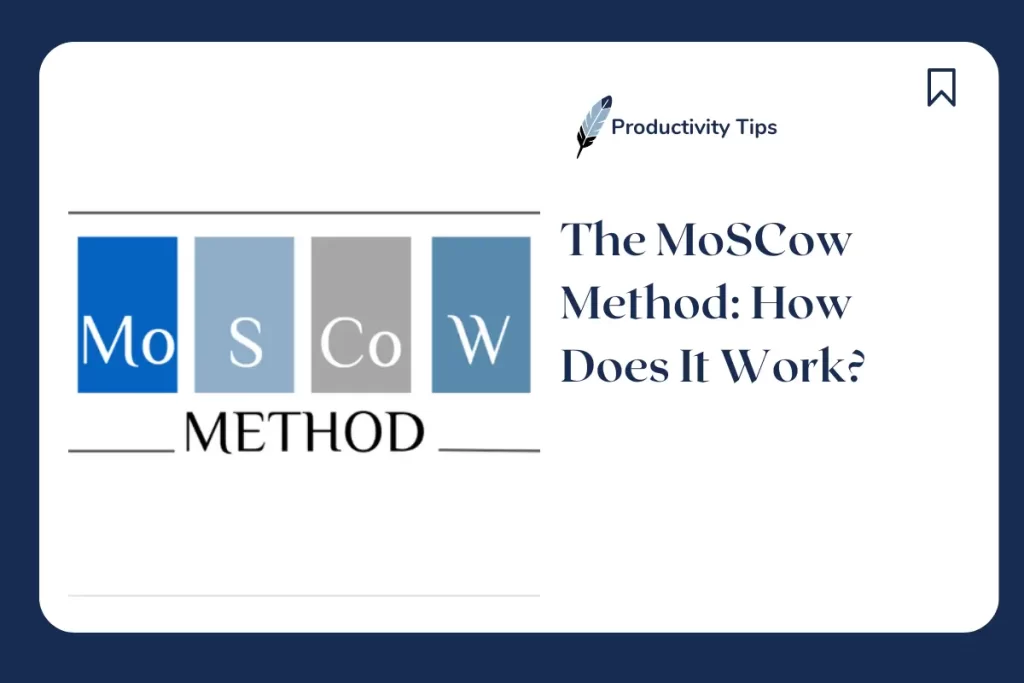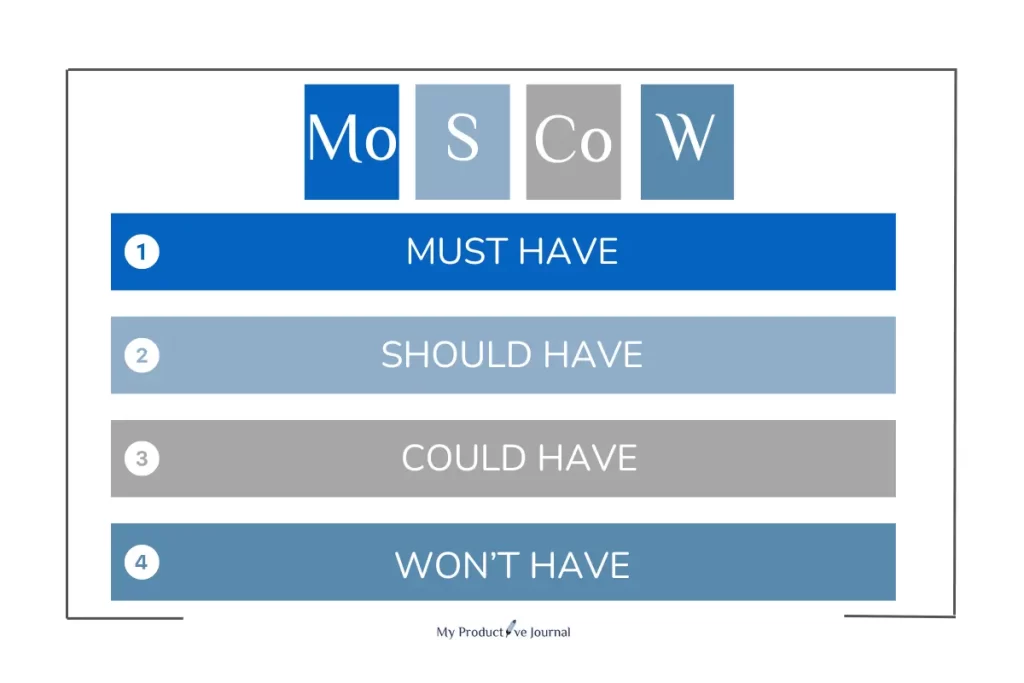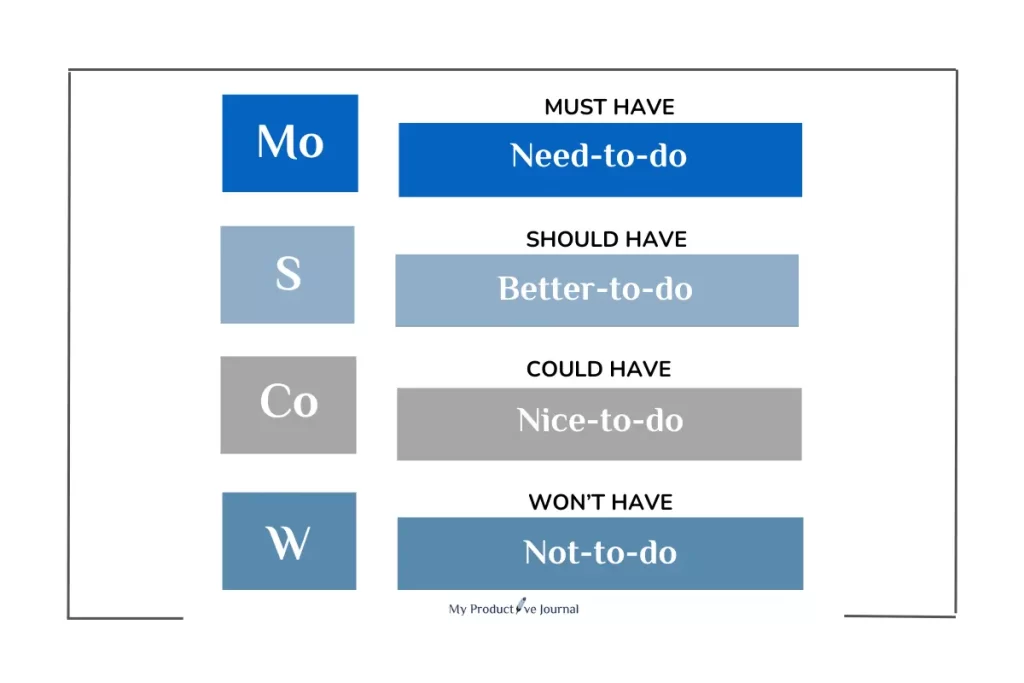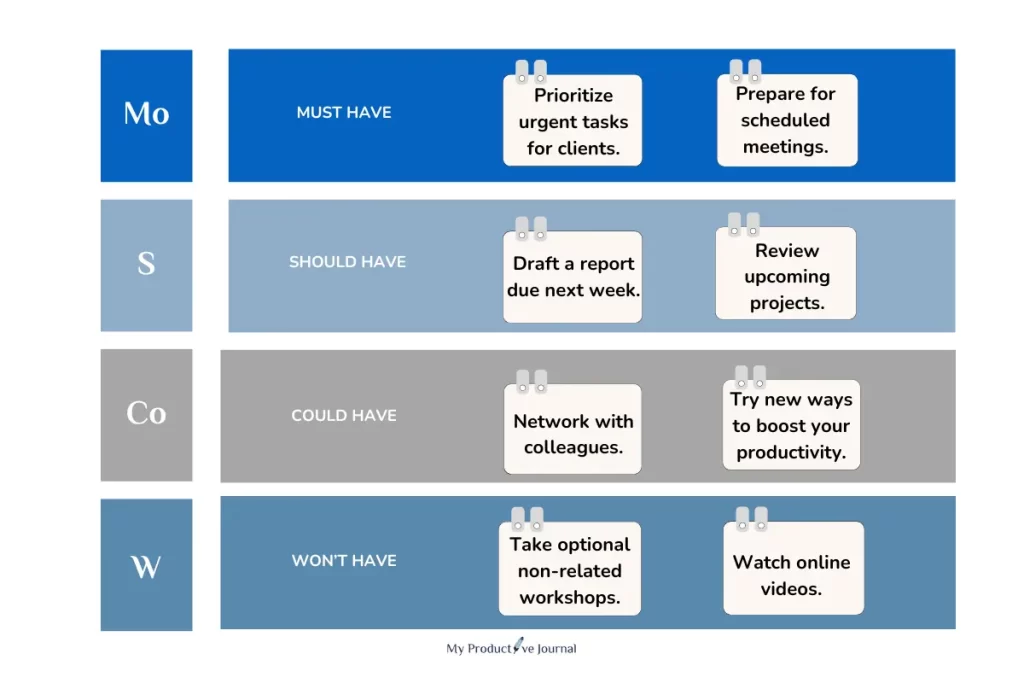Are you curious about the MoSCow method? You might think that it’s another productivity hack that promises you a life-changing approach, only to find that it wastes your time and energy.
But, the MoSCow method is unlike others. It offers something different from the typical productivity hack.
The acronym stands for Must-have, Should-have, Could-have, and Won’t-have.
To better understand what this method is about, let’s explore each of these categories in greater detail.
So keep reading.

According to a Harvard Business School article, prioritizing gives organizations a clear sense of direction. Therefore, it’s important to focus on activities aligned with your priorities and disregard others [1].
It’s your priorities that decide what to focus on. And, if something doesn’t align, you shouldn’t pay attention, even if it’s a trend.
The MoSCow method will structure and label your tasks. It will allow you to determine your priorities and differentiate between work and leisure time.
In my case, I learned to say no to people who do not support my priorities. I always keep in mind that my time and energy are both limited, so I use it wisely on essential tasks and people.
And if you’re struggling to prioritize your tasks, then keep on reading.
Table of Contents
What is the Moscow Method of Prioritization?
So, what is the Moscow method of prioritization? The Moscow Method of Prioritization, also known as MoSCoW analysis, is a method for determining and ranking tasks by priorities.
Let’s go into more depth on this, shall we?

Dai Clegg, a software development expert, developed this method while working for Oracle to assist his team in task prioritization [2].
It’s a technique in goal planning and task handling that highlights the duties you must do for today.
Everything falls into its proper place, if you apply the MoSCow Method.
Because you’ve gotta face the facts: one task at a time is the limit for our mental processing [3]. That’s why you need to rank your tasks and give them importance to bring some clarity to the chaos.
Can you see how it simplifies your task? Here’s a clearer idea of what I’m trying to say.
You can divide your tasks into four levels for easier organization.
Each label represents the following category:
- Must-have
- Should-have
- Could-have
- Won’t-have, will not have right now, or “wish.”
Let’s move on to the next section where I can elaborate further and provide more context.
How Does the Moscow Method Work?
You might be thinking how does this method work? Well, in a nutshell, the MoSCow Method revolves around this idea: Each task has its own value, but some are more critical.
I’ll explain in simple terms what each category stands for.

Must-have
- Non-negotiables
- Features that are legal or regulatory needs
- Tasks you can’t ignore
You cannot afford to neglect these tasks, as there will be a serious negative outcome. No matter what, you must do these tasks. ASAP.
Should-have
- Significant but optional for now
- Functional, not vital aspects
- Can-wait tasks
It is acceptable if you handle these tasks on the following day. Although not time-sensitive, it’s suggested that you handle these tasks sooner.
Could-have
- Nice-to-have features
- Extra enhancements
- Non-essential tasks
There are no time limitations for these tasks. You can complete them whenever suits your schedule because it is optional.
No specified deadline, but completing them could impact your productivity or emotional well-being.
Won’t-have
- Lowest priority items
- Ideas for future consideration
- Left-for-later tasks
These tasks are not for well-being or goals. It might be time eaters or tasks that aren’t adding value to your life.
What is an Example of the Moscow Technique?
I’ve outlined a work scenario to walk you through the process. Think of this as an illustration of how you can implement the MoSCow Technique.
You can arrange your tasks by determining the Must-have, Should-have, Could-have, and Won’t-have.
So, here are some examples:

- Must have
Tackle urgent client project tasks: You definitely need this here because you can’t afford to miss the deadline and disappoint your client.
- Should have
Plan for upcoming projects: You should make sure to have this because it’s important for keeping your clients in the loop.
- Could have
Explore new productivity tools and software: You should label it here because it’s not a high priority, but it would be worth having to keep yourself updated on what’s out there.
- Won’t have
Spend on social media during work hours: You can keep it low on your priority list for now. It’s a non-urgent task, so you can handle it whenever you take a break or have free time.
Click here to get the Moscow Method templates. You can save, copy, and print them.
When to Use the Moscow Method?
If you are unsure when to apply the MoSCow method, let me help you.
The MoSCoW approach is practical when you decide on task value and divide your resources.
First, you must define your goals. Identify task expectations and lay out clear, achievable outcomes. It will help you stay focused and motivated, as well as give you a clear path to follow.
Second, list all your tasks. Write out all the features or responsibilities you think your work requires. This will help you see what’s missing and what you need to include.
It’s time to turn plans into actions. You can use this method when:
- Running a project: Ensure that you give priority to the tasks that matter the most.
- Building software: Put your attention on the features that need immediate development.
- Planning an event: Make it a point to find the necessary tasks.
- Making a strategy: Organize your business goals by level of priority.
- Making a decision: Keep an eye on the factors that are key to your decision-making process.
- Managing your time: Decide on the tasks you want to begin with.
Yet, keep these points in mind: Adjusting your priorities is a continuous process. You must check and update it to maintain alignment with your vision.
What Are the Key Benefits of Moscow Technique?
So, what advantages can you gain from using the MoSCow Method?
Fortunately, communicating your needs and aspirations to your family or team will be much easier if you get comfortable with this technique.
Here are some of the benefits you can explore when implementing this method:
- You can line up your tasks under each category
Each label works as top priority, high priority, low priority, and not needed. It shows you the order of tasks and urgency.
- You will learn how to work with a team
It promotes shared effort in projects, which clarifies your tasks for a better team effort.
- You can achieve more
It simplifies decision-making by highlighting your top-priority tasks. It’s a quick and easy-to-follow method.
- You can develop flexibility
You can use this technique for diverse purposes like project planning and brainstorming. The method is perfect for personal use and team tasks.
- You can focus better
You can outline tasks for goal achievement. It’s also helpful in delegating roles since it defines roles in the project and first emphasizes critical (“must-have”) tasks.
Incorporating the Moscow Method with Other Productivity Techniques
I’ve selected three productivity methods you can combine with the Moscow Method to maximize its effectiveness.

A study from the International Journal of Higher Education found that satisfied teachers know how to rank, delegate, avoid multitasking, and maintain a positive attitude [4].
As I see it, all these are crucial for good output and achievable through practice and repetition.
So, if you want to get more out of the MoSCow Method, you “must” mix any of these three methods:
The 90/20 Rule
Here’s how to approach the 90/20 Rule:
Initially, you can use the MoSCoW method to organize tasks before starting a work period.
Each time you work for 90 minutes, center your focus on the ‘Must have’ assignments, as they’re the priority.
Use the 20-minute breaks to rest and rejuvenate. You can also test ‘Must have’ work progress during this time and gear up for the next focus period.
When your work slot has spare time, you can focus on ‘Should have’ and ‘Could have’ tasks.
Give the least priority to ‘Won’t have’ tasks and revisit when enough time and energy are available.
Pomodoro Technique
You can adapt the MoSCoW strategy at the beginning to line up tasks or projects for the day.
Then, set the timer for 25 minutes for execution to regulate your work intervals.
When the Pomodoro timer goes off, take a short break of 5 minutes. When the Pomodoro alarm beeps, rest for 5 minutes.
You can review your progress during this time. If you still have ‘Must have’ tasks left, repeat steps 3-5.
Once all ‘Must have’ tasks are complete, adopt the same process for ‘Should have’ and ‘Could have’ tasks if time allows.
The Ivy Lee Method
You must start classifying your tasks following the priority order: Must-have, Should-have, Could-have, and Won’t-have.
Organize the task list by priority, then follow the Ivy Lee Method.
Adopt a manageable quantity of tasks with the highest priority, six from the Ivy Lee Method, or according to your workload.
Start with the initial task, complete it, then proceed to the next.
Moscow Method (FAQs)
What is the MoSCoW method format?
The MoSCoW approach breaks down project duties into four key classifications: Must-Have, Should-Have, Could-Have, and Won’t-Have (right now).
What is MoSCoW analysis used for?
MoSCoW analysis enables the organization of tasks and components based on their relevance to project attainment.
What is the meaning of the word MoSCoW?
‘MoSCoW’ is an acronym for Must, Should, Could, and Won’t — symbols of task urgency in project administration.
How do you write MoSCoW requirements?
Writing MoSCoW requirements is creating a to-do list. This involves listing, categorizing, and refining the list of tasks as needed.
What is the MoSCoW strategy?
The MoSCoW method is a strategy that helps you choose which tasks to do first, second, third, and so on. You can rank your tasks into four categories: Must-Haves, Should-Haves, Could-Haves, and Won’t-Haves.
How does the MoSCoW method work?
The MoSCoW method classifies tasks as “Must,” “Should,” “Could,” or “Won’t.” How it works is to finish “Must haves” first, then manage other tasks as time allows.
What is the MoSCoW method of dealing?
MoSCoW is a task-ranking method in project management. By grouping tasks, it helps you identify what needs immediate attention and what can wait.
What is the meaning of the word MoSCoW?
Each letter has a specific meaning.
• M: Must have, meaning necessary, mandatory, or required.
• S: Should have, meaning preferable, beneficial, or valuable.
• C: Could have, meaning supplementary, optional, or extra.
• W: Won’t have, meaning not needed, unwanted, or ignored.
The ‘o’s in ‘MoSCoW’ are for phonetic reasons.
What to Do Next?
Now that you have grasped the MoSCow approach, it’s time to apply it. You can use it on your next project or apply it to your daily activities.
If you face challenges, you can reflect on the following:
- Which part didn’t work out?
- What alternative actions were possible?
- What changes will you make to excel next time?
If you do this, you will be able to hone your skills and be a better manager of your time.
Hey! If you found this post useful, check out these productivity tips and tools, too:
